Potential of Earth’s core as a reservoir for noble gases: Case for helium and neon
Affiliations | Corresponding Author | Cite as | Funding information- Share this article





-
Article views:500Cumulative count of HTML views and PDF downloads.
- Download Citation
- Rights & Permissions
top
Abstract
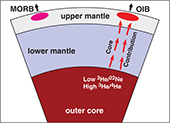
Figures and Tables
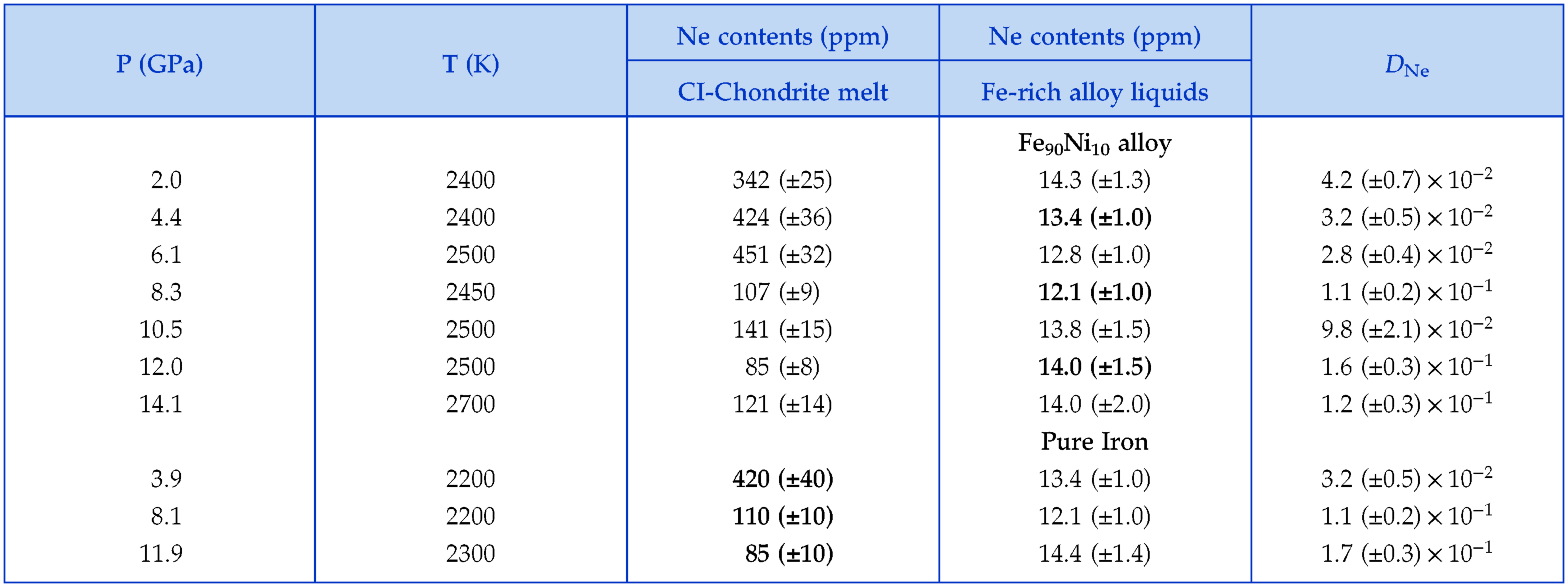 Table 1 Neon concentrations (ppm) in molten CI-chondrite and Fe-rich alloys liquids. Values in bold (either for metallic or silicate phases) are linear interpolations between the two nearest experimental pressure data. | 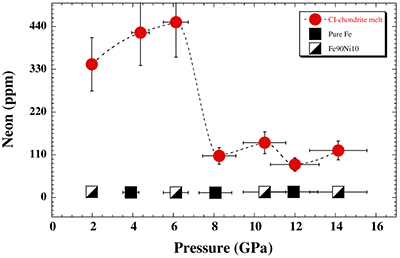 Figure 1 Neon concentrations in CI-chondrite melt, Fe and Fe90Ni10 alloy at high pressures. The reported Ne contents represent the average of 5 to 20 analyses. Error bars correspond to 1σ (ranging from 5 to 20 %) of the average of the chemical analyses and to 10 % of the nominal pressures reported. For the metallic phase no pressure dependence is observed and the average value of Ne concentrations is 13.5 ± 0.8 ppm. | 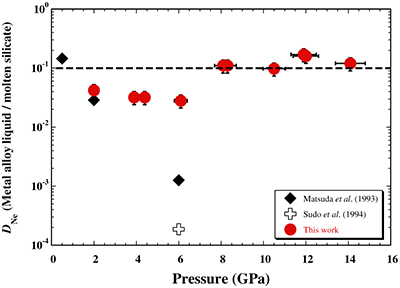 Figure 2 Partition coefficients of Neon, DNe (wt. % of Ne in metallic phase / wt. % of Ne in silicate) between molten silicate and iron-rich metal liquids as a function of pressure. The average value of our experiments at high pressure is represented by the dashed line. The previous data from Matsuda et al. (1993) and Sudo et al. (1994) are also plotted. At this stage the discrepancy between data sets at 6 GPa is unknown. | 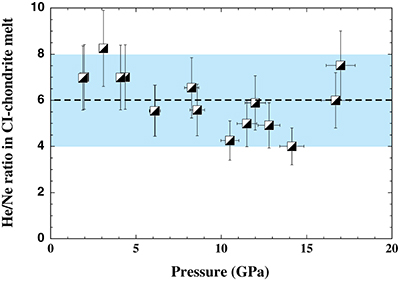 Figure 3 He/Ne ratio (wt. % of He in the melt / wt. % of Ne in the melt) in CI-chondrite melt at high pressures. |
| Table 1 | Figure 1 | Figure 2 | Figure 3 |
top
Letter
Earth’s mantle contains a mixture of primordial noble gases, in particular solar-type helium and neon, and radiogenic noble gases (e.g., Marty, 2012
Marty, B. (2012) The origins and concentrations of water, carbon, nitrogen and noble gases on Earth. Earth and Planetary Science Letters 313–314, 56–66.
; Moreira, 2013Moreira, M. (2013) Noble gas constraints on the origin and evolution of Earth’s volatiles. Geochemical Perspectives 2, 229–403.
). The isotopic ratios of He and Ne in ocean island basalts (OIB) indicate the existence of a reservoir with high concentrations of primordial noble gases in the deep Earth. This reservoir appears to have been isolated from the MORB (Mid-Ocean Ridge Basalts) source reservoir 4.4 billion years ago (e.g., Pepin and Porcelli, 2006Pepin, R.O., Porcelli, D. (2006) Xenon isotope systematics, giant impacts, and mantle degassing on the early Earth. Earth and Planetary Science Letters 250, 470–485.
; Mukhopadhyay, 2012Mukhopadhyay, S. (2012) Early differentiation and volatile accretion recorded in deep-mantle neon and xenon. Nature 486, 101–104.
; and references therein).The origin of high 3He/4He and low 3He/22Ne ratios in many OIBs is still much debated and there has long been a supposition that OIBs sample a primordial and undegassed reservoir located in the deep mantle. Increasing evidence for mantle convection processes has pushed the debated boundary for a primitive mantle source location ever deeper into the lower mantle, reaching the core-mantle boundary (e.g., Williams et al., 2019
Williams, C.D., Mukhopadhyay, S., Rudolph, M.L., Romanowicz, B. (2019) Primitive helium is sourced from seismically slow regions in the lower most mantle. Geochemistry, Geophysics, Geosystems 20, 4130–4145.
). The Earth’s core has also been suggested as an alternative source of noble gases (Porcelli and Halliday, 2001Porcelli, D., Halliday, A.N. (2001) The core as a possible source of mantle helium. Earth and Planetary Science Letters 192, 45–56.
; Trieloff and Kunz, 2005Trieloff, M., Kunz, J. (2005) Isotope systematics of noble gases in the Earth’s mantle: possible sources of primordial isotopes and implications for mantle structure. Physics of the Earth and Planetary Interiors 148, 13–38.
; Armytage et al., 2013Armytage, R., Jephcoat, A.P., Bouhifd, M.A., Porcelli, D. (2013) Metal-silicate partitioning of iodine at high pressures and temperatures: implications for the Earth’s core and 129Xe budgets. Earth and Planetary Science Letters 373, 140–149.
; Bouhifd et al., 2013Bouhifd, M.A., Jephcoat, A.P., Heber, V.S., Kelley, S.P. (2013) Helium in Earth’s early core. Nature Geoscience 6, 982–986.
; Roth et al., 2019Roth, A.S.G., Liebske, C., Maden, C., Burton, K.W., Schönbächler, M., Busemann, H. (2019) The primordial He budget of the Earth set by percolative core formation in planetesimals. Geochemical Perspectives Letters 9, 26–31.
).Extending our previous work on helium, here we investigate neon partitioning between molten silicates and Fe-rich alloy liquids up to 16 GPa and to a maximum temperature of ∼3000 K. We also address the behaviour of He/Ne in an early magma ocean.
A CI-chondrite model composition was chosen for the starting silicate material (e.g., Bouhifd et al., 2013
Bouhifd, M.A., Jephcoat, A.P., Heber, V.S., Kelley, S.P. (2013) Helium in Earth’s early core. Nature Geoscience 6, 982–986.
). To simulate Earth’s core formation under conditions of segregation from a deep magma ocean, we performed experiments with a starting mix of CI-chondrite glass (66 wt. %) with various Fe-rich alloys (34 wt. %).We used a set-up described in previous studies (e.g., Jephcoat et al., 2008
Jephcoat, A.P., Bouhifd, M.A., Porcelli, D. (2008) Partitioning experiments in the laser-heated diamond anvil cell: volatile content in the Earth’s core. Philosophical Transactions Royal Society A 366, 4295–4314.
) with all details reported in the Supplementary Information. Briefly, we used diamond anvils with 500 μm culets, and stainless steel gaskets pre-indented to a thickness of ∼50 μm and drilled to a diameter of ∼100 μm. Samples were mounted in the pressure chamber and neon was loaded with a high pressure gas-loading technique at 200 MPa. Pressures were measured using the ruby fluorescence method before and after each heating stage. The samples were heated by a 100 W air-cooled fibre laser with emission centred at 1070 nm for an average of about 15 minutes for each zone of the sample. During the heating stage the surrounding neon melted by conductive heating from the heated sample, allowing its dissolution into the sample. Temperatures were determined spectro-radiometrically with a fit to a grey-body Planck function. The temperatures of our runs were higher by at least 200 degrees than the liquidus temperature of peridotite (Zhang and Herzberg, 1994Zhang, J., Herzberg, C. (1994) Melting experiments on anhydrous peridotite KLB-1 from 5.0 to 22.5 GPa. Journal of Geophysical Research 99, 17729–17742.
; Fig. S-2). Because our experiments are not routine the success of our LHDAC technique was demonstrated in our previous studies where we found a good agreement between our results and those provided from large volume presses for argon (Fig. S-3a,b).The chemical compositions of the run products were analysed by an electron microprobe (JEOL JXA-8800R with 4 wavelength dispersive spectrometers) with an accelerating voltage of 15 kV and a beam current of 20 nA (see Table S-1). The chemical analyses for neon with the UVLAMP were carried out at the Open University, UK. A NewWave UP213 combined laser/microscope system uses a 10 Hz quintupled Nd-YAG laser with a wavelength of 213 nm yielding ∼10 ns pulses (Heber et al., 2007
Heber, V.S., Brooker, R.A., Kelley, S.P., Wood, B.J. (2007) Crystal-melt partitioning of noble gases (helium, neon, argon, krypton and xenon) for olivine and clinopyroxene. Geochimica et Cosmochimica Acta 71, 1041–1061.
). The extracted gas was cleaned using three SAES AP-10 getters at 400 °C and room temperature to remove active gases before analysis with a MAP 215–50 noble gas mass spectrometer. Blanks were measured before and after each ablation and all the measured blanks were small with respect to the minimum neon concentrations measured in our samples. For both silicate and metal analyses, the measured 22Ne blanks were (0.6 ± 0.1) × 10−12 cm3 STP. To convert measured Ne abundances into concentrations, the volumes of all laser pits were determined by using a non-contact, vertical scanning white light interferometer (Zygo instrument), which has a vertical resolution of ∼1 Å and a horizontal resolution of 1 μm.The experimental conditions, the neon contents of the run products and the resulting partition coefficients for neon are presented in Table 1. Each of the reported results is the average of several spot analyses made from the same phase. During Ne analysis, we ablated the first 2 microns from the surface before starting the quantitative determinations of Ne concentrations. This step is made to avoid the high near-surface concentrations of noble gases (e.g., Bouhifd et al., 2013
Bouhifd, M.A., Jephcoat, A.P., Heber, V.S., Kelley, S.P. (2013) Helium in Earth’s early core. Nature Geoscience 6, 982–986.
). Therefore, the neon contents presented here correspond to neon dissolved in the bulk molten phases quenched from HP.Table 1 Neon concentrations (ppm) in molten CI-chondrite and Fe-rich alloys liquids. Values in bold (either for metallic or silicate phases) are linear interpolations between the two nearest experimental pressure data.
| P (GPa) | T (K) | Ne contents (ppm) | Ne contents (ppm) | DNe |
| CI-Chondrite melt | Fe-rich alloy liquids | |||
| Fe 90 Ni 10 alloy | ||||
| 2.0 | 2400 | 342 (±25) | 14.3 (±1.3) | 4.2 (±0.7) × 10−2 |
| 4.4 | 2400 | 424 (±36) | 13.4 (±1.0) | 3.2 (±0.5) × 10−2 |
| 6.1 | 2500 | 451 (±32) | 12.8 (±1.0) | 2.8 (±0.4) × 10−2 |
| 8.3 | 2450 | 107 (±9) | 12.1 (±1.0) | 1.1 (±0.2) × 10−1 |
| 10.5 | 2500 | 141 (±15) | 13.8 (±1.5) | 9.8 (±2.1) × 10−2 |
| 12.0 | 2500 | 85 (±8) | 14.0 (±1.5) | 1.6 (±0.3) × 10−1 |
| 14.1 | 2700 | 121 (±14) | 14.0 (±2.0) | 1.2 (±0.3) × 10−1 |
| Pure Iron | ||||
| 3.9 | 2200 | 420 (±40) | 13.4 (±1.0) | 3.2 (±0.5) × 10−2 |
| 8.1 | 2200 | 110 (±10) | 12.1 (±1.0) | 1.1 (±0.2) × 10−1 |
| 11.9 | 2300 | 85 (±10) | 14.4 (±1.4) | 1.7 (±0.3) × 10−1 |
Here we found that the neon solubility in silicate melt dropped by a factor of ∼3 (Fig. 1) from ∼450 ppm Ne at 6 GPa to ∼140 ppm Ne at 10 GPa. This drop of neon solubility can be attributed to the characteristic of silicate melts at high pressures as reported in our study for argon (Bouhifd and Jephcoat, 2006
Bouhifd, M.A., Jephcoat, A.P. (2006) Aluminium control of argon solubility in silicate melts under pressure. Nature 439, 961–964.
). We also found no evidence for a pressure dependence of Ne solubility in Fe-rich alloys. It is important to note here that the drop of Ne solubility in silicate melt by a factor of 3 will only vary the DNe coefficient from 3 × 10−2 at 6 GPa (before the drop of Ne solubility in the silicate melt) to 9.8 × 10−2 at 10 GPa (after the drop of Ne solubility). The variation of DNe of less than one order of magnitude was taken into account in our calculations and was found not to affect the main conclusion of the present work. Previous studies show that the core can be a plausible source for light noble gases using much lower (∼10−4) partition coefficients of He and Ne, meaning that the metal-silicate partition coefficients of noble gases are not the only limiting factor. The main controlling factor being the abundances of noble gases in the proto-Earth (Porcelli and Halliday, 2001Porcelli, D., Halliday, A.N. (2001) The core as a possible source of mantle helium. Earth and Planetary Science Letters 192, 45–56.
; Trieloff and Kunz, 2005Trieloff, M., Kunz, J. (2005) Isotope systematics of noble gases in the Earth’s mantle: possible sources of primordial isotopes and implications for mantle structure. Physics of the Earth and Planetary Interiors 148, 13–38.
).
Figure 1 Neon concentrations in CI-chondrite melt, Fe and Fe90Ni10 alloy at high pressures. The reported Ne contents represent the average of 5 to 20 analyses. Error bars correspond to 1σ (ranging from 5 to 20 %) of the average of the chemical analyses and to 10 % of the nominal pressures reported. For the metallic phase no pressure dependence is observed and the average value of Ne concentrations is 13.5 ± 0.8 ppm.
Measurements of Ne partitioning between metal and silicate have been reported by Matsuda et al. (1993)
Matsuda, J., Sudo, M., Ozima, M., Ito, K., Ohtaka, O., Ito, E. (1993) Noble gas partitioning between metal and silicate under high pressures. Science 259, 788–790.
and Sudo et al. (1994)Sudo, M., Ohtaka, O., Matsuda, J. (1994) Noble gas partitioning between metal and silicate under high pressures: The case of iron and peridotite. In: Matsuda, J. (Ed.) Noble Gas Geochemistry and Cosmochemistry. Terra Scientific Publishing Company (TERRAPUB), Tokyo, 355–372.
. These studies indicate high DNe of ∼10−1 at P ∼0.5 GPa that decreased with increasing pressure to near 10−3 at 6 GPa. At about 2 GPa, our DNe value is similar to that determined by Matsuda et al. (1993)Matsuda, J., Sudo, M., Ozima, M., Ito, K., Ohtaka, O., Ito, E. (1993) Noble gas partitioning between metal and silicate under high pressures. Science 259, 788–790.
. However, at pressures ≥2 GPa, we do not observe the systematic decrease in the DNe coefficients, instead our results indicate higher DNe coefficients of ∼10−1 at pressures >8 GPa, which is little dependent on pressure (Fig. 2). This behaviour is similar to that of helium for which we found that DHe coefficients are constant over a wide range of pressure up to 40 GPa (Bouhifd et al., 2013Bouhifd, M.A., Jephcoat, A.P., Heber, V.S., Kelley, S.P. (2013) Helium in Earth’s early core. Nature Geoscience 6, 982–986.
). We assume thus that the DNe is within 10−2−10−1 at the conditions of Earth’s core formation that can reach conditions in the range of 30–70 GPa and 3500 K as determined from moderately siderophile elements.
Figure 2 Partition coefficients of Neon, DNe (wt. % of Ne in metallic phase / wt. % of Ne in silicate) between molten silicate and iron-rich metal liquids as a function of pressure. The average value of our experiments at high pressure is represented by the dashed line. The previous data from Matsuda et al. (1993)
Matsuda, J., Sudo, M., Ozima, M., Ito, K., Ohtaka, O., Ito, E. (1993) Noble gas partitioning between metal and silicate under high pressures. Science 259, 788–790.
and Sudo et al. (1994)Sudo, M., Ohtaka, O., Matsuda, J. (1994) Noble gas partitioning between metal and silicate under high pressures: The case of iron and peridotite. In: Matsuda, J. (Ed.) Noble Gas Geochemistry and Cosmochemistry. Terra Scientific Publishing Company (TERRAPUB), Tokyo, 355–372.
are also plotted. At this stage the discrepancy between data sets at 6 GPa is unknown.Assuming a global magma ocean during core formation, our experimental solubilities of Ne and He into a chondritic melt show that under a hot, dense atmosphere from which volatiles are dissolved, such a magma ocean would have been enriched in He with respect to Ne. The reported [He/Ne] ratio (wt. % of He/wt. % of Ne in chondritic melt) shows a negligible dependence on pressure up to 17 GPa with an average of 6 ± 2 (Fig. 3). Because the solubility factor ratio of He by Ne is at most 2 (e.g., Jambon et al., 1986
Jambon, A., Weber, H., Braun, O. (1986) Solubility of He, Ne, Ar, Kr and Xe in a basalt melt in the range 1250–1600 °C: Geochemical implications. Geochimica et Cosmochimica Acta 50, 401–408.
), an early magma ocean would have presented a ratio 3He/22Ne within 2.5–5, reflecting up to two global melting events during the first 100 million years of Earth’s history (Tucker and Mukhopadhyay, 2014Tucker, J.M., Mukhopadhyay, S. (2014) Evidence for multiple magma ocean outgassing and atmospheric loss episodes from mantle noble gases. Earth and Planetary Science Letters 393, 254–265.
). For the estimate above, we consider that the initial 3He/22Ne ratio is that of the solar nebula or of implanted solar wind during the early solar system, around 1.50 ± 0.06, and 0.9 ± 0.1, respectively (e.g., Yokochi and Marty, 2004Yokochi, R., Marty, B. (2004) A determination of the neon isotopic composition of the deep mantle. Earth and Planetary Science Letters 225, 77–88.
; Heber et al., 2009Heber, V.S., Wieler, R., Baur, H., Olinger, C., Friedmann, T.A., Burnett, D.S. (2009) Noble gas composition of the solar wind as collected by the Genesis mission. Geochimica et Cosmochimica Acta 73, 7414–7432.
; Raquin and Moreira, 2009Raquin, A., Moreira, M. (2009) Atmospheric 38Ar/36Ar in the mantle: implications for the nature of the terrestrial parent bodies. Earth and Planetary Science Letters 287, 551–558.
; Tucker and Mukhopadhyay, 2014Tucker, J.M., Mukhopadhyay, S. (2014) Evidence for multiple magma ocean outgassing and atmospheric loss episodes from mantle noble gases. Earth and Planetary Science Letters 393, 254–265.
).
Figure 3 He/Ne ratio (wt. % of He in the melt / wt. % of Ne in the melt) in CI-chondrite melt at high pressures.
In order to evaluate the potential of He and Ne sequestration by the core, it is necessary to estimate the initial abundances of these noble gases on proto-Earth. In the early part of Earth’s history, high concentrations of He and Ne that might have existed as Xe isotopes indicate extensive losses of volatile elements from the mantle within the first 100 Myr. Such losses appear to have depleted the noble gases by ≥97 %, implying that their initial concentrations in Earth were two orders of magnitude higher than at present (Porcelli et al., 2001
Porcelli, D., Wollun, D., Cassen, P. (2001) Deep Earth rare gases: initial inventories, capture from the solar nebula, and losses during Moon formation. Earth and Planetary Science Letters 193, 237–251.
; Yokochi and Marty, 2005Yokochi, R., Marty, B. (2005) Geochemical constraints on mantle dynamics in the Hadean. Earth and Planetary Science Letters 238, 17–30.
). The amounts of primitive helium and neon can thus be estimated from the present day 3He and 22Ne concentrations in the mantle that range between 2.2 and >14 × 10−10 cc STP/g for 3He and between 4 and >58 × 10−11 cc STP/g for 22Ne (Yokochi and Marty, 2004Yokochi, R., Marty, B. (2004) A determination of the neon isotopic composition of the deep mantle. Earth and Planetary Science Letters 225, 77–88.
; Moreira and Kurz, 2013Moreira, M., Kurz, M.D. (2013) Noble gases as tracers of mantle processes and magmatic degassing. In: Burnard, P. (Ed.) The Noble Gases as Geochemical Tracers. Advances in Isotope Geochemistry. Springer-Verlag, Berlin, Heidelberg, 371–391.
). We can thus estimate that 3He primitive mantle’s concentrations are in the range of ∼1012 3He atoms/g. In addition, the initial Earth 3He/4He ratio was around 120 × RA (where RA = 1.39 × 10−6 is the atmospheric ratio) if solar nebula was trapped in the mantle; or 330 × RA that represents the solar wind ratio, provided that terrestrial He was derived from solar wind implantation of accreting materials (Porcelli et al., 2001Porcelli, D., Wollun, D., Cassen, P. (2001) Deep Earth rare gases: initial inventories, capture from the solar nebula, and losses during Moon formation. Earth and Planetary Science Letters 193, 237–251.
).By considering the values reported above, abundances of about 2.7 × 1012 3He atoms/g and 2.9 × 1012 22Ne atoms/g in the early Earth’s mantle are very plausible. By taking these values as the initial 3He and 22Ne abundances at time of the core formation, and the measured DHe and DNe, 3He and 22Ne in the early core could have been between 1.3 × 1010 and 4.6 × 1010 3He atoms/g, and between 8.1 × 1010 and 4.9 × 1011 22Ne atoms/g, respectively. These estimates indicate that the Earth’s early core might have had a 3He/22Ne ratio lower than 0.6. During core formation, the 3He/22Ne ratio of the mantle should be within the range 2.5–5, and the metal-silicate partition coefficient of the He/Ne ratio is about 5 × 10−2 (Fig. S-9) leading to a 3He/22Ne ratio within the core in the range of 0.12–0.25. We can thus conclude that the Earth’s core must have inherited low 3He/22Ne ratio (<0.6), and any contribution from the core to the OIBs source regions has the potential to lower their 3He/22Ne ratios.
The measured high 3He/4He and low 3He/22Ne ratios observed now in some OIBs (such as Hawaii) could be the result from mixing of He and Ne from a small core component with radiogenic 4He and residual 3He and 22Ne from the mantle. Our new estimates, based on the ratio of the fluxes of noble gases in OIBs to their concentrations in the core, would require that less than 1 % of the mass of the core should have released its primordial light noble gases.
Since significant amounts of siderophile elements are incorporated in the core, additions of core material to the OIBs would impact these elements. For modern OIBs, tungsten isotopic data negatively correlate with 3He/4He ratios (Mundl et al., 2017
Mundl, A., Touboul, M., Jackson, M.G., Day, J.M.D., Kurz, M.D., Lekic, V., Helz, R.T., Walker, R.J. (2017) Tungsten-182 heterogeneity in modern ocean island basalts. Science 356, 66–69.
). This correlation can indicate core-mantle interaction with transfer of the high 3He/4He and low 182W signature of the outer core to the source of the OIBs. A similar conclusion was reached in a more recent study by Rizo et al. (2019)Rizo, H., Andrault, D., Bennett, N.R., Humayun, M., Brandon, A., Vlastelic, I., Moine, B., Poirier, A., Bouhifd, M.A., Murphy, D.T. (2019) 182W evidence for core-mantle interaction in the source of mantle plumes. Geochemical Perspectives Letters 11, 6–11.
where they found that core-mantle exchange might be facilitated by exsolution of W-rich, Si-Mg-Fe oxides from the core into the mantle. A correlation between the highest 3He/4He values and the highest 186Os/188Os ratios in Hawaii was also used as an evidence for a core contribution to He and Os (Walker et al., 1995Walker, R.J., Morgan, J.W., Horan, M.F. (1995) Osmium-187 enrichment in some plumes: evidence for core-mantle interaction? Science 269, 819–822.
). However, subsequent studies in other OIBs show that this evidence in OIBs cannot be uniquely tied to the core (Luguet et al., 2008Luguet, A., Pearson, D.G., Nowell, G.M., Dreher, S.T., Coggon, J.A., Spetsius, Z.V., Parman, S.W. (2008) Enriched Pt-Re-Os isotope systematics in plume lavas explained by metasomatic sulfides. Science 319, 453–456.
). Clearly, the debate over core-mantle exchanges has some way to go, but the present study shows that the early Earth’s core could have incorporated helium and neon making it a potential supplier of light noble gases into deep-rooted mantle plumes. Also the Earth’s core must have inherited high 3He/4He ratios (in the range 120–330) and low 3He/22Ne ratios (<0.6), and the core maintained high and low, 3He/4He and 3He/22Ne ratios, respectively, throughout Earth’s history.top
Acknowledgements
To the memory of our friend and colleague Pete Burnard with whom we have had many discussions about the origin of noble gases on Earth. We would like to thank Steve Parman and an anonymous reviewer for comments and suggestions that help us to improve our manuscript. MAB acknowledges the support of a NERC and the PNP-CNRS program. This work was also supported by NERC grants to APJ. This is Laboratory of Excellence ClerVolc contribution number 429.
Editor: Helen Williams
top
References
Armytage, R., Jephcoat, A.P., Bouhifd, M.A., Porcelli, D. (2013) Metal-silicate partitioning of iodine at high pressures and temperatures: implications for the Earth’s core and 129Xe budgets. Earth and Planetary Science Letters 373, 140–149.
 Show in context
Show in context The Earth’s core has also been suggested as an alternative source of noble gases (Porcelli and Halliday, 2001; Trieloff and Kunz, 2005; Armytage et al., 2013; Bouhifd et al., 2013; Roth et al., 2019).
View in article
Bouhifd, M.A., Jephcoat, A.P. (2006) Aluminium control of argon solubility in silicate melts under pressure. Nature 439, 961–964.
 Show in context
Show in context This drop of neon solubility can be attributed to the characteristic of silicate melts at high pressures as reported in our study for argon (Bouhifd and Jephcoat, 2006).
View in article
Bouhifd, M.A., Jephcoat, A.P., Heber, V.S., Kelley, S.P. (2013) Helium in Earth’s early core. Nature Geoscience 6, 982–986.
 Show in context
Show in context The Earth’s core has also been suggested as an alternative source of noble gases (Porcelli and Halliday, 2001; Trieloff and Kunz, 2005; Armytage et al., 2013; Bouhifd et al., 2013; Roth et al., 2019).
View in article
A CI-chondrite model composition was chosen for the starting silicate material (e.g., Bouhifd et al., 2013).
View in article
This step is made to avoid the high near-surface concentrations of noble gases (e.g., Bouhifd et al., 2013).
View in article
This behaviour is similar to that of helium for which we found that DHe coefficients are constant over a wide range of pressure up to 40 GPa (Bouhifd et al., 2013).
View in article
Heber, V.S., Brooker, R.A., Kelley, S.P., Wood, B.J. (2007) Crystal-melt partitioning of noble gases (helium, neon, argon, krypton and xenon) for olivine and clinopyroxene. Geochimica et Cosmochimica Acta 71, 1041–1061.
 Show in context
Show in context A NewWave UP213 combined laser/microscope system uses a 10 Hz quintupled Nd-YAG laser with a wavelength of 213 nm yielding ∼10 ns pulses (Heber et al., 2007).
View in article
Heber, V.S., Wieler, R., Baur, H., Olinger, C., Friedmann, T.A., Burnett, D.S. (2009) Noble gas composition of the solar wind as collected by the Genesis mission. Geochimica et Cosmochimica Acta 73, 7414–7432.
 Show in context
Show in context For the estimate above, we consider that the initial 3He/22Ne ratio is that of the solar nebula or of implanted solar wind during the early solar system, around 1.50 ± 0.06, and 0.9 ± 0.1, respectively (e.g., Yokochi and Marty, 2004; Heber et al., 2009; Raquin and Moreira, 2009; Tucker and Mukhopadhyay, 2014).
View in article
Jambon, A., Weber, H., Braun, O. (1986) Solubility of He, Ne, Ar, Kr and Xe in a basalt melt in the range 1250–1600 °C: Geochemical implications. Geochimica et Cosmochimica Acta 50, 401–408.
 Show in context
Show in context Because the solubility factor ratio of He by Ne is at most 2 (e.g., Jambon et al., 1986), an early magma ocean would have presented a ratio 3He/22Ne within 2.5–5, reflecting up to two global melting events during the first 100 million years of Earth’s history (Tucker and Mukhopadhyay, 2014).
View in article
Jephcoat, A.P., Bouhifd, M.A., Porcelli, D. (2008) Partitioning experiments in the laser-heated diamond anvil cell: volatile content in the Earth’s core. Philosophical Transactions Royal Society A 366, 4295–4314.
 Show in context
Show in context We used a set-up described in previous studies (e.g., Jephcoat et al., 2008) with all details reported in the Supplementary Information.
View in article
Luguet, A., Pearson, D.G., Nowell, G.M., Dreher, S.T., Coggon, J.A., Spetsius, Z.V., Parman, S.W. (2008) Enriched Pt-Re-Os isotope systematics in plume lavas explained by metasomatic sulfides. Science 319, 453–456.
 Show in context
Show in context However, subsequent studies in other OIBs show that this evidence in OIBs cannot be uniquely tied to the core (Luguet et al., 2008).
View in article
Marty, B. (2012) The origins and concentrations of water, carbon, nitrogen and noble gases on Earth. Earth and Planetary Science Letters 313–314, 56–66.
 Show in context
Show in context Earth’s mantle contains a mixture of primordial noble gases, in particular solar-type helium and neon, and radiogenic noble gases (e.g., Marty, 2012; Moreira, 2013).
View in article
Matsuda, J., Sudo, M., Ozima, M., Ito, K., Ohtaka, O., Ito, E. (1993) Noble gas partitioning between metal and silicate under high pressures. Science 259, 788–790.
 Show in context
Show in context Measurements of Ne partitioning between metal and silicate have been reported by Matsuda et al. (1993) and Sudo et al. (1994).
View in article
At about 2 GPa, our DNe value is similar to that determined by Matsuda et al. (1993).
View in article
The previous data from Matsuda et al. (1993) and Sudo et al. (1994) are also plotted.
View in article
Moreira, M. (2013) Noble gas constraints on the origin and evolution of Earth’s volatiles. Geochemical Perspectives 2, 229–403.
 Show in context
Show in context Earth’s mantle contains a mixture of primordial noble gases, in particular solar-type helium and neon, and radiogenic noble gases (e.g., Marty, 2012; Moreira, 2013).
View in article
Moreira, M., Kurz, M.D. (2013) Noble gases as tracers of mantle processes and magmatic degassing. In: Burnard, P. (Ed.) The Noble Gases as Geochemical Tracers. Advances in Isotope Geochemistry. Springer-Verlag, Berlin, Heidelberg, 371–391.
 Show in context
Show in context The amounts of primitive helium and neon can thus be estimated from the present day 3He and 22Ne concentrations in the mantle that range between 2.2 and >14 × 10−10 cc STP/g for 3He and between 4 and >58 × 10−11 cc STP/g for 22Ne (Yokochi and Marty, 2004; Moreira and Kurz, 2013).
View in article
Mukhopadhyay, S. (2012) Early differentiation and volatile accretion recorded in deep-mantle neon and xenon. Nature 486, 101–104.
 Show in context
Show in context This reservoir appears to have been isolated from the MORB (Mid-Ocean Ridge Basalts) source reservoir 4.4 billion years ago (e.g., Pepin and Porcelli, 2006; Mukhopadhyay, 2012; and references therein).
View in article
Mundl, A., Touboul, M., Jackson, M.G., Day, J.M.D., Kurz, M.D., Lekic, V., Helz, R.T., Walker, R.J. (2017) Tungsten-182 heterogeneity in modern ocean island basalts. Science 356, 66–69.
 Show in context
Show in context For modern OIBs, tungsten isotopic data negatively correlate with 3He/4He ratios (Mundl et al., 2017).
View in article
Pepin, R.O., Porcelli, D. (2006) Xenon isotope systematics, giant impacts, and mantle degassing on the early Earth. Earth and Planetary Science Letters 250, 470–485.
 Show in context
Show in context This reservoir appears to have been isolated from the MORB (Mid-Ocean Ridge Basalts) source reservoir 4.4 billion years ago (e.g., Pepin and Porcelli, 2006; Mukhopadhyay, 2012; and references therein).
View in article
Porcelli, D., Halliday, A.N. (2001) The core as a possible source of mantle helium. Earth and Planetary Science Letters 192, 45–56.
 Show in context
Show in context The Earth’s core has also been suggested as an alternative source of noble gases (Porcelli and Halliday, 2001; Trieloff and Kunz, 2005; Armytage et al., 2013; Bouhifd et al., 2013; Roth et al., 2019).
View in article
The main controlling factor being the abundances of noble gases in the proto-Earth (Porcelli and Halliday, 2001; Trieloff and Kunz, 2005).
View in article
Porcelli, D., Wollun, D., Cassen, P. (2001) Deep Earth rare gases: initial inventories, capture from the solar nebula, and losses during Moon formation. Earth and Planetary Science Letters 193, 237–251.
 Show in context
Show in context Such losses appear to have depleted the noble gases by ≥97 %, implying that their initial concentrations in Earth were two orders of magnitude higher than at present (Porcelli et al., 2001; Yokochi and Marty, 2005).
View in article
In addition, the initial Earth 3He/4He ratio was around 120 × RA (where RA = 1.39 × 10−6 is the atmospheric ratio) if solar nebula was trapped in the mantle; or 330 × RA that represents the solar wind ratio, provided that terrestrial He was derived from solar wind implantation of accreting materials (Porcelli et al., 2001).
View in article
Raquin, A., Moreira, M. (2009) Atmospheric 38Ar/36Ar in the mantle: implications for the nature of the terrestrial parent bodies. Earth and Planetary Science Letters 287, 551–558.
 Show in context
Show in context For the estimate above, we consider that the initial 3He/22Ne ratio is that of the solar nebula or of implanted solar wind during the early solar system, around 1.50 ± 0.06, and 0.9 ± 0.1, respectively (e.g., Yokochi and Marty, 2004; Heber et al., 2009; Raquin and Moreira, 2009; Tucker and Mukhopadhyay, 2014).
View in article
Rizo, H., Andrault, D., Bennett, N.R., Humayun, M., Brandon, A., Vlastelic, I., Moine, B., Poirier, A., Bouhifd, M.A., Murphy, D.T. (2019) 182W evidence for core-mantle interaction in the source of mantle plumes. Geochemical Perspectives Letters 11, 6–11.
 Show in context
Show in context A similar conclusion was reached in a more recent study by Rizo et al. (2019) where they found that core-mantle exchange might be facilitated by exsolution of W-rich, Si-Mg-Fe oxides from the core into the mantle.
View in article
Roth, A.S.G., Liebske, C., Maden, C., Burton, K.W., Schönbächler, M., Busemann, H. (2019) The primordial He budget of the Earth set by percolative core formation in planetesimals. Geochemical Perspectives Letters 9, 26–31.
 Show in context
Show in context The Earth’s core has also been suggested as an alternative source of noble gases (Porcelli and Halliday, 2001; Trieloff and Kunz, 2005; Armytage et al., 2013; Bouhifd et al., 2013; Roth et al., 2019).
View in article
Sudo, M., Ohtaka, O., Matsuda, J. (1994) Noble gas partitioning between metal and silicate under high pressures: The case of iron and peridotite. In: Matsuda, J. (Ed.) Noble Gas Geochemistry and Cosmochemistry. Terra Scientific Publishing Company (TERRAPUB), Tokyo, 355–372.
 Show in context
Show in context Measurements of Ne partitioning between metal and silicate have been reported by Matsuda et al. (1993) and Sudo et al. (1994).
View in article
The previous data from Matsuda et al. (1993) and Sudo et al. (1994) are also plotted.
View in article
Trieloff, M., Kunz, J. (2005) Isotope systematics of noble gases in the Earth’s mantle: possible sources of primordial isotopes and implications for mantle structure. Physics of the Earth and Planetary Interiors 148, 13–38.
 Show in context
Show in context The Earth’s core has also been suggested as an alternative source of noble gases (Porcelli and Halliday, 2001; Trieloff and Kunz, 2005; Armytage et al., 2013; Bouhifd et al., 2013; Roth et al., 2019).
View in article
The main controlling factor being the abundances of noble gases in the proto-Earth (Porcelli and Halliday, 2001; Trieloff and Kunz, 2005).
View in article
Tucker, J.M., Mukhopadhyay, S. (2014) Evidence for multiple magma ocean outgassing and atmospheric loss episodes from mantle noble gases. Earth and Planetary Science Letters 393, 254–265.
 Show in context
Show in context Because the solubility factor ratio of He by Ne is at most 2 (e.g., Jambon et al., 1986), an early magma ocean would have presented a ratio 3He/22Ne within 2.5–5, reflecting up to two global melting events during the first 100 million years of Earth’s history (Tucker and Mukhopadhyay, 2014).
View in article
For the estimate above, we consider that the initial 3He/22Ne ratio is that of the solar nebula or of implanted solar wind during the early solar system, around 1.50 ± 0.06, and 0.9 ± 0.1, respectively (e.g., Yokochi and Marty, 2004; Heber et al., 2009; Raquin and Moreira, 2009; Tucker and Mukhopadhyay, 2014).
View in article
Walker, R.J., Morgan, J.W., Horan, M.F. (1995) Osmium-187 enrichment in some plumes: evidence for core-mantle interaction? Science 269, 819–822.
 Show in context
Show in context A correlation between the highest 3He/4He values and the highest 186Os/188Os ratios in Hawaii was also used as an evidence for a core contribution to He and Os (Walker et al., 1995).
View in article
Williams, C.D., Mukhopadhyay, S., Rudolph, M.L., Romanowicz, B. (2019) Primitive helium is sourced from seismically slow regions in the lower most mantle. Geochemistry, Geophysics, Geosystems 20, 4130–4145.
 Show in context
Show in context Increasing evidence for mantle convection processes has pushed the debated boundary for a primitive mantle source location ever deeper into the lower mantle, reaching the core-mantle boundary (e.g., Williams et al., 2019).
View in article
Yokochi, R., Marty, B. (2004) A determination of the neon isotopic composition of the deep mantle. Earth and Planetary Science Letters 225, 77–88.
 Show in context
Show in context For the estimate above, we consider that the initial 3He/22Ne ratio is that of the solar nebula or of implanted solar wind during the early solar system, around 1.50 ± 0.06, and 0.9 ± 0.1, respectively (e.g., Yokochi and Marty, 2004; Heber et al., 2009; Raquin and Moreira, 2009; Tucker and Mukhopadhyay, 2014).
View in article
The amounts of primitive helium and neon can thus be estimated from the present day 3He and 22Ne concentrations in the mantle that range between 2.2 and >14 × 10−10 cc STP/g for 3He and between 4 and >58 × 10−11 cc STP/g for 22Ne (Yokochi and Marty, 2004; Moreira and Kurz, 2013).
View in article
Yokochi, R., Marty, B. (2005) Geochemical constraints on mantle dynamics in the Hadean. Earth and Planetary Science Letters 238, 17–30.
 Show in context
Show in context Such losses appear to have depleted the noble gases by ≥97 %, implying that their initial concentrations in Earth were two orders of magnitude higher than at present (Porcelli et al., 2001; Yokochi and Marty, 2005).
View in article
Zhang, J., Herzberg, C. (1994) Melting experiments on anhydrous peridotite KLB-1 from 5.0 to 22.5 GPa. Journal of Geophysical Research 99, 17729–17742.
 Show in context
Show in context The temperatures of our runs were higher by at least 200 degrees than the liquidus temperature of peridotite (Zhang and Herzberg, 1994;
View in article
top
Supplementary Information
The Supplementary Information includes:
- Starting Materials
- Experimental Techniques
- Table S-1
- Figures S-1 to S-9
- Supplementary Information References
Download the Supplementary Information (PDF).
Figures
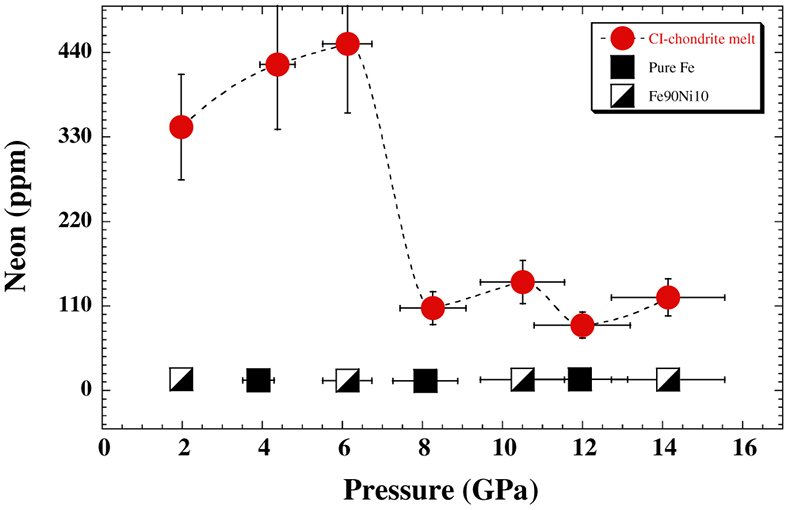
Figure 1 Neon concentrations in CI-chondrite melt, Fe and Fe90Ni10 alloy at high pressures. The reported Ne contents represent the average of 5 to 20 analyses. Error bars correspond to 1σ (ranging from 5 to 20 %) of the average of the chemical analyses and to 10 % of the nominal pressures reported. For the metallic phase no pressure dependence is observed and the average value of Ne concentrations is 13.5 ± 0.8 ppm.
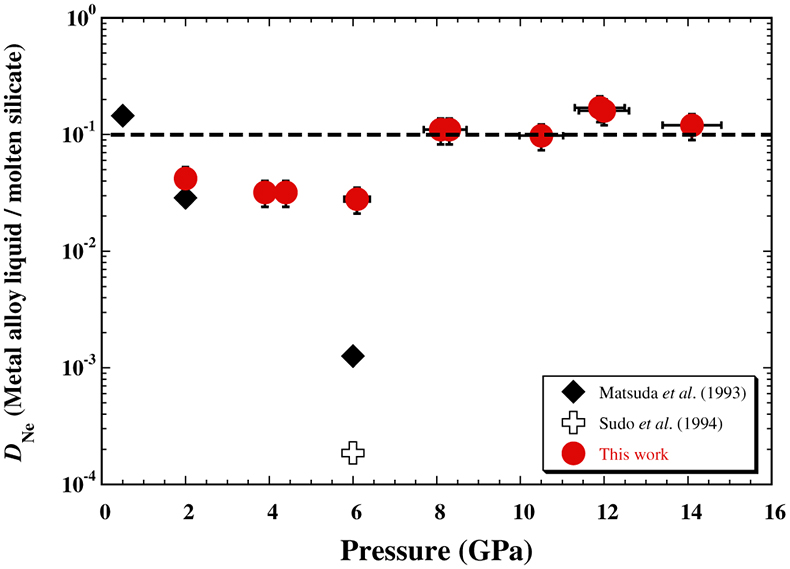
Figure 2 Partition coefficients of Neon, DNe (wt. % of Ne in metallic phase / wt. % of Ne in silicate) between molten silicate and iron-rich metal liquids as a function of pressure. The average value of our experiments at high pressure is represented by the dashed line. The previous data from Matsuda et al. (1993)
Matsuda, J., Sudo, M., Ozima, M., Ito, K., Ohtaka, O., Ito, E. (1993) Noble gas partitioning between metal and silicate under high pressures. Science 259, 788–790.
and Sudo et al. (1994)Sudo, M., Ohtaka, O., Matsuda, J. (1994) Noble gas partitioning between metal and silicate under high pressures: The case of iron and peridotite. In: Matsuda, J. (Ed.) Noble Gas Geochemistry and Cosmochemistry. Terra Scientific Publishing Company (TERRAPUB), Tokyo, 355–372.
are also plotted. At this stage the discrepancy between data sets at 6 GPa is unknown.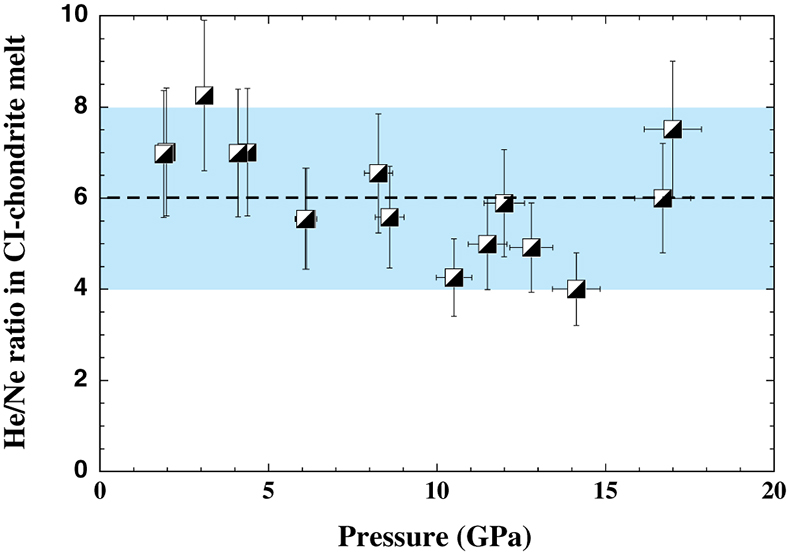
Figure 3 He/Ne ratio (wt. % of He in the melt / wt. % of Ne in the melt) in CI-chondrite melt at high pressures.






